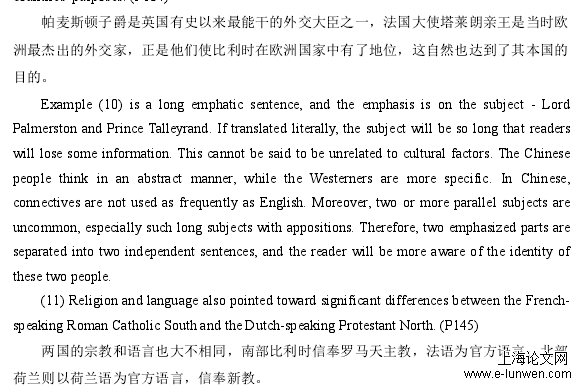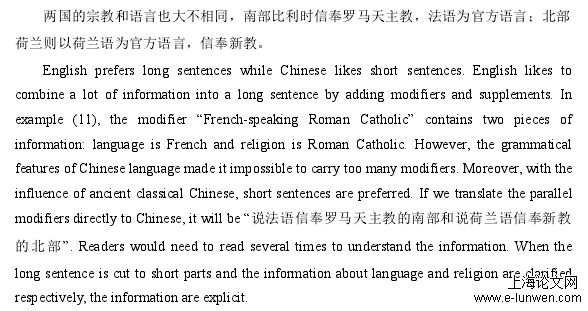The source text UNFINISHED BUSINESS: Why international negotiations fail analyzes the causes of failed cases from a new angle. The translation of this book from English to Chinese will provide more knowledge about international negotiations. Hence, Chinese negotiators could avoid similar mistakes and increase success rate in future international negotiations.It takes one year from the pre-translation preparations to the finish of final version after multiple proofreading. Under the guidance of cultural linguistics, the translator tries her best to make the translation in line with the original text and meet the reading requirements of Chinesereaders. Cultural linguistics elaborates on the relationship between language and culture. Cultureaffects language and language reflects culture. It is undeniable that the two are interrelated andinseparable. The translator focuses on the differences between English and Chinese from theperspective of thinking patterns and grammar. Translators whose mother tongue is Chinese areunconsciously influenced by the Han nationality’s way of thinking, especially by the structure ofChinese grammar and the choice of words with Han culture. As for the translationstrategies,precise selections of words are needed to consider when we have many choices of words. Part ofspeech is often changed from noun to verb if the center of English sentence is noun. The use offour-character and free translation can make the sentence clear and short. At syntactic level,translators prefer to separate and reorganize long sentences and reverse the order of sentence toemphasize key information.However, the translation still has many limitations. Due to the limited knowledge aboutinternational negotiations, the translation of some terminologies is not accurate enough. At thesame time, although the translator has read relevant historical materials, they’re not first-handinformation. It is impossible to fully and objectively understand the entire historical event. That means the understanding of part of the original text may be biased.Hence, it’s hoped that other translators can re-translate the article from a new perspective.Under the guidance of other theories, various factors can be considered more comprehensively toreduce mistranslation. On the other hand, translation works on international negotiations are stillrare in China. However, China’s foreign exchanges have become more frequent, and the ongoingOne Belt One Road Initiative is inseparable from international negotiations. Whether they arepolitical inter-governmental exchanges or economic cooperation between enterprises, it is veryimportant to master international negotiation skills. We hope that more translators will analyzetranslations in the field of negotiations from a more professional perspective in the future.
.........
Chapter Ⅰ Introduction
Negotiation is just the bridge connecting people from different cultures and provides aplatform for them to solve problems in a mild way. Nevertheless, the positions of two negotiatingparties and the specific goals they pursue are different, and even opposite. Hence, the negotiationprocess is often full of sharp and complicated conflicts of interest and repeated bargaining. Thetask of negotiators is to implement various effective strategies in specific situations, correctlyhandle and resolve conflicts and contradictions between them, seek consensus, and reach a fairand reasonable agreement acceptable to both parties.UNFINISHED BUSINESS: Why international negotiations fail written by Guy OlivierFaure presents an innovative approach to understanding international negotiations. This bookcombines thematic research on the causes of failure with illustrative case studies to provide astructured way to explore this subject. The book can even help readers who are not familiar withnegotiation theory to grasp the complexity of basic concepts and background. Bertrand I. Spector,the executive director of the Negotiation Analysis Center and editor-in-chief of the InternationalJournal of Theory and Practice, commented that “this excellent work is about the resilience ofcountries facing a stalemate in resolving their conflicts and how to reinvigorate the negotiationprocess to reverse the deadlock. This book fills the gaps in the literature with an analytical andcomparative perspective and is optimistic that negotiations can be an effective tool for solvingdifficult conflicts.” (Faure, 2012)
........
Chapter Ⅱ Translation Task
2.1 Task Analysis
UNFINISHED BUSINESS focuses on the reasons for the failure of internationalnegotiations. There are totally seven chapters which can be divided into three parts.The first part of the book contains the introduction and seven case studies, such as the UNSecurity Council and Iraq, the Cyprus conflict and the Biological Weapons Convention, and thesource text, the Negotiations on the Status of Belgium is also one of them. These case studiesshow different types of failed negotiations: bilateral, multilateral, and mediation (threeperspectives). The second part of the book analyzes the empirical findings from these cases andthe causes of failure in four ways: actors, structure, strategy, and process. The final part ofUNFINISHED BUSINESS is two summative chapters that give broader conclusions, boththeoretically and practically.As a case study, the source text is very clear in structure with two sections. In the firstsection, thearticle details the whole event, from background, development, conflicts, mediation,interruption, to final result. Since the 16th century, Belgium, although it was a small country, hadalways been an important place to compete for occupation among powerful countries. Thissituation became more serious in the 19th century. Belgium was also a victim of the powerstruggles and balances among major European countries, mainly including Britain, France,Austria, andRussia. They had been negotiating for three years on the status of Belgium from1830 to 1833. During this period new difficulties and contradictions emerged. No one waswilling to compromise, and no consensus could be reached. Finally, the negotiations weresuspended for another five years until 1838. In 1839, related parties signed the agreement, whichwas not because the parties have found a perfect solution to the conflict, but because theyunderstood that this was the end result and there would be no more self-interested agreements astime flied. The author truly and thoroughly restored this little-known history to the readers. In thesecond section, the author gave her own analysis, explaining the reasons for the failure of theLondon Conference negotiations from six perspectives: perceived power asymmetry, themediator’s role, strategic issues, lack of trust, forward- vs backward-looking outcomes andmutually hurting stalemate and mutually enticing opportunity.


2.2 Text Analysis
The first section of this article is written in a narrative way. The author firstly introduces thehistorical background. The second section is the author’s argumentation. By discussing thedevelopment of event, the author analyzes the affairs, expresses her own opinions and makes herown claims. She provides six reasons and dissects the rationality of each reason based on facts.The author mainly uses concepts, judgments, and reasoning to express her views or clarify thetruth. Long sentences are also used frequently to clarify the author’s judgments and analysis. Forexample, the author often uses parallel and progressive phrases to present the complicated event,which involves multiple parties; long and parallel modifiers, clauses and appositions are alsofound in these long sentences with complex structure.From the lexical point of view, the author mainly uses accurate, rigorous and general wordsto convince readers. Meanwhile, she also expresses her own subjective views and deep personalfeelings by means of some vivid words and even rhetoric devices, especially in the secondsection. In addition, as this article involves the professional knowledge of negotiations, there aresome negotiating terminologies. For example, when analyzing the reasons for the failure of thenegotiations, the author proposed two technical terms: Mutually Hurting Stalemate (MHS) and Mutually Enticing Opportunity (MEO). The author briefly explains the meaning of these twowords, and then combines them with the facts. In this way, even readers who never meet thesetwo terms will not feel very confused.

......
Chapter Ⅲ Cultural Linguistics····················7
3.1 Western Cultural Linguistics························7
3.2 Chinese Cultural Linguistics·············· 8
Chapter Ⅳ Case Studies·············10
4. 1 Selection of Words················10
4.2 Conversion of Part of Speech········ 10
4.3 Use of Four-Characters················ 12
4.4 Free Translation··········12
4.5 Separation of Sentences·················· 13
4.6 Reversion of Sentences·············· 14
4.7 Reorganization of Sentences················14
ChapterⅤConclusion···············16
..........
Chapter Ⅳ Case Studies
4. 1 Selection of Words
The four-character is the representative of Chinese classical culture. It is a gem and reflectsthe profoundness of the Chinese language. The four-character has a beauty of rhyme, theneatness of form, and the beauty of image. Influenced by traditional culture and aestheticpsychology, Chinese has gradually formed an aesthetic rule of “taking double as the best”. Thefour-character is divided into two types, idiomatic four-character and ordinary four-character.The idiomatic four-character refers to an idiom with a strict structure and cannot be split at will,while the latter is not fixed in form, and can be freely combined according to the context.In the translation of long sentences between English and Chinese, “reorganization ofsentence” often appears. The sentence structure of English is like a big tree, in which subject andpredicate are key parts and the rest is like branches connected by prepositions or associated
words. If the sentence were translated literally, the information would be confusing. Thetranslator firstly needs to sort out the logical relationship of the original sentence, and then putthe relevant information in sequence. At this time, the importance of each piece of information inthe original sentence should also be considered.(10) It was Lord Palmerston, one of the ablest foreign secretaries England ever had, and theFrench ambassador Prince Talleyrand, the most prominent figure in European diplomacy of thattime, who gave Belgium its status among the European nations, naturally to suit theirowncountries’purposes. (P134)
4.2 Conversion of Part of Speech
English and Chinese Sentences have great differences in syntactic structures. English is alinear hypotaxis language whose sentence structure is like a big tree. The subject and predicateare the main part, and the rest parts are like branches connecting through prepositions andassociated words; while Chinese is parataxis and more concise. The sentence mainly relies onsemantic connection and is free in form.(8) This can be achieved by improving mediator’s capacity to understand the problem, byfollowing up on promises, by demonstrating a genuine interest in trying to help the two sidesreach their objectives, by not using threats or ultimatums, or by making concession and showingthe two sides that they can gain from negotiations more than by not negotiating at all (P142).Influenced by cultures, the thinking patterns of English and Chinese are obviously different.English often comes straight to the point, first showing the conclusion, then demonstrating,describing or telling the facts; Chinese, however, is accustomed to a “gradual progress”, often inaccordance with the order of development of things, from facts to conclusions. In translation, theorder of the sentence can be totally reversed in semantic sense.(9) It was only a matter of time before Belgian grievances would turn into violent protest.(P132)
.........
References
[1] Andresen, Julie Telel. Linguistics in America 1789-1924:Acritical History. London andNew York: Doutledge.1990.
[2] Boas, F. Language and Culture. Cambridge: Cambridge University Press. 1966.
[3] Casson R W. Schemata in Cognitive Anthropology. Palo Alto: Annual Reviews,1983:429-462.
[4] Darnel, Renga. “Franz Boas, Edward Sapir and the American Text Tradition” InHistoriographia Linguistica. 1990.
[5] Ellwood, Cahrles A. Theories of Cultural Evolution. The American Journal of Sociology.1918: 23.
[6] Faure, Guy Olivier. Escalation and Negotiation in International Conflicts Cambridge:Cambridge University Press, 2005.
[7] Faure, Guy Olivier. UNFINISHED BUSINESS: Why International Negotiations Fail [M].Georgia: Georgia University Press, 2012.
[8] Foley W.A. Antoropogical Linguistics: Anintroduction Blackwell Publishers Ltd.1997.
[9] Frank, R.M. A future agenda for research on language and culture. The Routledgehandbook of language and culture. London: Routledge, 2015.
[10] Kress, G. R. Sentence Complexity in Contrastive Linguistics. In G. www.zhonghualw.comNickel. (ed.) Papers inContrastive Linguistics. Cambridge: Cambridge University Press, 1971.
............

